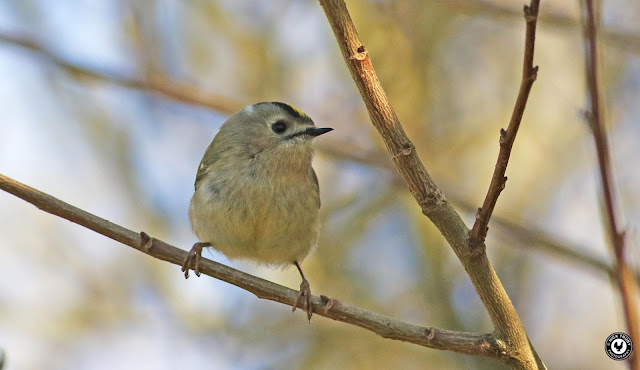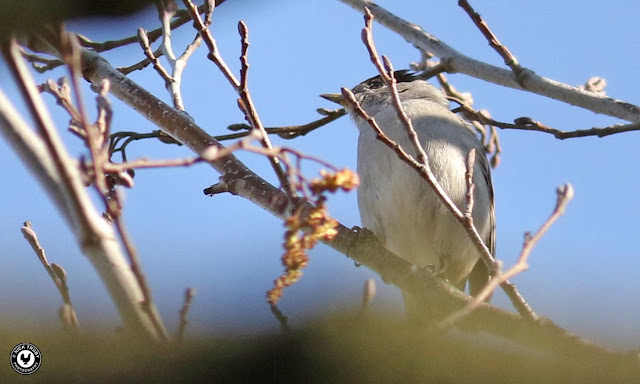The breeding birds will be here for the summer so there may be opportunities later in the season to see most of them, provided the lockdown is lifted of course. Passage birds will be missed, unless we're able to get them on return migration in the autumn. There are some spring birds that arrive in April that are much sought after by Mrs Caley and I. Unfortunately none of them are available in the Bicester area, unless we get very lucky on our new walking route to Ardley and back. Those birds are Grasshopper Warbler, usually need to go to Otmoor for those, Nightingale, hard to find in the county so usually travel to Bedfordshire for them, Little Gulls, Arctic Terns and Black Terns, all usually pass through Farmoor during mid-April and migrating Wading Birds, best seen at Farmoor or Otmoor. Rarer birds can of course occur anywhere. All of those locations and birds are now off limits owing to the current travel restrictions.
So we have to make the most of any available birding locations that can accessed either by foot directly from home or by driving the short distance to the Wetlands Reserve on the other side of town. In my last two blogs I detailed a walk that we've found, that goes from our house to Ardley where there are a couple of small pools and a stand of mature trees. This walk was now the mainstay of our birding, in tandem with quite a bit of skywatching from the garden. I had returned to work so the Easter weekend was my first opportunity to resume birding again.
Good Friday 10th April: More surprises!
We were out early on a pleasant warm and sunny morning and heading towards Trow Pool as we'd done on a few occasions now. The Swallow at the farm had now been joined by another and the Long-tailed Tits nest appeared complete and was becoming hard to spot owing to the leaves now being almost fully unfurled. A large flock of Wood Pigeons took to the air as we walked the familiar path past the horse paddocks. At the first ploughed field I spied a Red Kite perched in a tree, still warming itself up this early in the day. I think Red Kites look more menacing when they are inactive at rest, their piercing eyes seem to follow you as you walk past, and they lack the gracefulness that they exhibit when on the wing.
 |
| Red Kite |
 |
| Skylark |
 |
| Linnets |
 |
| Corn Bunting |
 |
| Stock Dove |
 |
| Common Whitethroat |
 |
| Curlew |
 |
| Moorhen |
 |
| Rook |
 |
| Jay |
In the afternoon I sat out in the garden once again hopeful of a flyover Osprey which, yet again, didn't appear, not that I was ever really thinking that one would, but if you don't look then you won't get so you may as well look! So I took some time to photograph some our garden birds, this time concentrating on the humble Starlings. In bright sunny light there can't be many better looking birds than a Starling, their glossy feathers in hues of greens, purples and blacks are as stunning as any exotic species from far flung countries. In my garden Starlings are frequent users of the water fall on the pond which they visit for a wash and brush up.
 |
| Starling |
 |
| Robin |
Saturday 11th April: Relaxation at Home and Nearby
After the stress of queueing for our right to shop at the local supermarket at the far too late new eight a.m. opening time, we usually shop at six o'clock in the morning, we headed to Bicester Wetlands after breakfast to see what was around. Justin had reported a Sedge Warbler the day before and for us that would be new for the year. As soon as we'd taken our seats in the hide we could hear the Sedge Warbler's erratic and vibrant song coming from the reedbed but the bird itself stayed resolutely hidden. We weren't really feeling it today, good birds were beginning to be reported from around the country and indeed even in Oxfordshire, but we were unable to go anywhere to see them. This left me feeling pretty hopeless so I just sat gazing halfheartedly out of the hide window and not showing enough interest in the few birds that were on the reserve. I felt pathetic for feeling so pathetic when in the grand scheme of things my own emotional state wasn't important when compared to what other people were going through. Harbouring thoughts about missing out on some spring migrants and passage birds left me feeling guilty and selfish when I knew that they'd all be there to see next year, but for me seeing the birds each year constitutes a big part of my own wellbeing and I felt low.
A bird was moving through the small reedbed and I attempted to track it. It was skulking and never left the base of the reed stems until it reached the edge of the cut and then when it whirred across to the road on its tiny little wings, a Wren of course, I slumped down a bit more onto the hide bench. The only thing that kept me there that morning was knowing that the Sedge Warbler would bolster the year list. Normally I wouldn't worry about Sedge Warblers because, during any walk onto Otmoor in spring and summer, Sedgies would literally be crawling up your arm! But at the moment we couldn't access Otmoor or anywhere else locally that would hold Sedge Warblers, or Reed Warblers for that matter, so it only left our local wetlands reserve as a place to see them. Another bird was bending the reeds as it hopped through them. This one did jump up to the top of a reed but proved to be a Common Whitethroat, which we already had on the list from yesterday. The Sedge Warbler was still calling periodically but was proving to be a tease.
 |
| Common Whitethroat |
 |
| Jackdaw |
With the weather being so fine I, like a lot of folk I guess, spent the afternoon pretending to be a gardener but in reality I was just idling, enjoying the sunshine and, in my case, watching the birds that visited the garden instead. As on the day before it was very therapeutic staring heavenwards hoping for a flyover vulture or stork (joke) but as before I ended up watching the Starlings taking baths in the waterfall and the other birds that made sorties to the feeders.
 |
| Dunnock |
 |
| Starling |
 |
| Rook |
 |
| Wood Pigeon |
Easter Sunday 12th April: Wishful Thinking
We were up early and drove the couple of miles to Trow Pool, getting there by six in the morning. A few Grasshopper Warblers had been reported from around the country, and indeed in Oxon, and I was hopeful that I'd find one on the new patch. The track through the corridor of trees and bushes was alive with birds but I was focussed on getting down to the Gagle Brook where I fancied there was habitat that might attract a Gropper or even a Nightingale at some point this spring. It was still early in the year for returning migrants but I had conjured up a bit of excitement from somewhere and I couldn't wait to go and have a look for some. It was sunny again for the umpteenth day in a row and as we walked down the track, I strained my ears listening hard for any familiar and unfamiliar birdsong, whether lodged or not in my memory. Unsurprisingly, however, it was only the usual suspects that made up the dawn chorus.
We reached the Quarry pool and studied the Tufted Ducks and Coots for a while and I scanned the edges for the Jack Snipe but again there was no sign so it must have moved on. There were none of the anticipated Hirundines, they'd surely be arriving en masse soon, but it was still early in the morning and there may be some about later in the day since they are day flying migrants so may not have left their overnight coastal roosts yet.
 |
| Tufted Duck |
After ten minutes or so of scanning the leaf litter beneath a small copse and not finding the desired gang of Woodcocks, we retraced our steps. The usual birdsong accompanied us, Blackcaps were again prevalent but Chiffchaffs, a Willow Warbler and many common species were audible too. We met another yampy Goldcrest, not quite as territorial as the one of a week before, but again proving just how feisty these tiny birds are.
 |
| Goldcrest |
 |
| Common Buzzard |
 |
| Peregrine Falcon |
 |
| Peregrine on the Chimneys |
 |
| Blackcap |
 |
| Little Grebe |
 |
| Moorhen |
 |
| Song Thrush |
Easter Monday 13th April: Cold Weather for a Change
The morning was chilly and overcast so we remained in the warm kitchen watching the garden birds. It wasn't until almost ten o'clock that we ventured out and drove once more to Trow Pool for another crack at finding something different. There would be no glorious sunshine at all today and the wind was strong enough to blow the tree branches around quite considerably. As a result birds were keeping a low profile and thus the walk down to the pool was quiet on all sides. A Red Kite dispatching a meal while on the wing was the only bird of note that we saw.
 |
| Red Kite |
 |
| House Martin |
 |
| Peregrine |
 |
| Common Buzzard |





















































